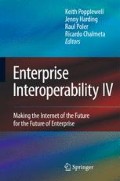Abstract
The Pipes-and-Filters (PaF) Architecture has been prominently exploited in the context of Enterprise Application Integration (EAI). The individual tasks have typically been implemented using specialized EAI-vendor technology, message flows, and quite often customer-specific implementations. This implementation approach is in conflict with flow technology, a cornerstone of the Service-Oriented Architecture (SOA). We show in this paper how this conflict can be resolved. We first show how the PaF architecture can be implemented using flow technology by transforming the appropriate PaF patterns, in particular those used in EAI, into appropriate WS-BPEL constructs. We then present the results of appropriate tests that show that the performance of the corresponding workflows is superior to the mapping of PaF patterns to message flows. We finish off with outlining the additional tangible and non-tangible benefits that the Workflow Management System (WfMS) provides, such as monitoring and process instance management. In a nut shell, we illustrate that the PaF architecture does not require an own implementation. It is sufficient to have a PaF modeling tool and then convert the appropriate models to workflows for execution by an appropriate WfMS.
Access this chapter
Tax calculation will be finalised at checkout
Purchases are for personal use only
Preview
Unable to display preview. Download preview PDF.
References
M. J. Bach. The Design of the UNIX Operating System. Prentice Hall, June 1986.
B. Blakeley, H. Harris, and R. Lewis. Messaging and Queuing using the MQI. McGraw-Hill, Inc., New York, NY, USA, 1995.
eviware. soapUI. http://www.eviware.com, 2009.
Organization for the Advancement of Structured Information Standards (OASIS). Web Services Business Process Execution Language (WS-BPEL) Version 2.0 - OASIS Standard. http://docs.oasis-open.org/wsbpel/2.0/wsbpel-v2.0.htm, 2007.
D. Garlan and M. Shaw. An introduction to software architecture. In Advances in Software Engineering and Knowledge Engineering, pages 1–39. World Scientific Publishing Company, 1993.
J. Gray and A. Reuter. Transaction Processing: Concepts and Techniques. Morgan Kaufmann Publishers, Inc., 1993.
G. Hohpe and B. Woolf. Enterprise Integration Patterns: Designing, Building, and Deploying Messaging Solutions. Addison-Wesley Professional, 2003.
IBM Corporation. IBM WebSphere Enterprise Service Bus. http://www-01.ibm.com/software/integration/wsesb/, 2009.
IBM Corporation. IBM WebSphere Process Server. http://www-01.ibm.com/software/integration/wps/library/, 2009.
C. Isaacson. Software pipelines: A new approach to high-performance business applications, 2007.
F. Leymann and D. Roller. Modeling Business Processes with BPEL4WS. Information Systems and e-Business Management (ISeB), 2005.
F. Leymann and D. Roller. Production Workflow: Concepts and Techniques. Prentice-Hall, Upper Saddle River, New Jersey, 2000.
R. Meunier. The pipes and filters architecture, pages 427–440. ACM Press/Addison-Wesley Publishing Co., New York, NY, USA, 1995.
T. Scheibler and F. Leymann. A Framework for Executable Enterprise Application Integration Patterns. In 4th International Conference Interoperability for Enterprise Software and Applications (I-ESA 2008), March 2008.
T. Scheibler, R. Mietzner, and F. Leymann. EMod: Platform Independent Modelling, Description and Enactment of Parameterisable EAI Patterns. Enterprise Information Systems, 3(3): 299–317, 2009.
D. E. Perry, and A. L. Wolf. Foundations for the study of software architecture. ACM SIGSOFT Software Engineering Notes, 17: 40–52, 1992.
Author information
Authors and Affiliations
Editor information
Editors and Affiliations
Rights and permissions
Copyright information
© 2010 Springer-Verlag London Limited
About this paper
Cite this paper
Scheibler, T., Roller, D., Leymann, F. (2010). From Pipes-and-Filters to Workflows. In: Popplewell, K., Harding, J., Poler, R., Chalmeta, R. (eds) Enterprise Interoperability IV. Springer, London. https://doi.org/10.1007/978-1-84996-257-5_24
Download citation
DOI: https://doi.org/10.1007/978-1-84996-257-5_24
Publisher Name: Springer, London
Print ISBN: 978-1-84996-256-8
Online ISBN: 978-1-84996-257-5
eBook Packages: EngineeringEngineering (R0)

